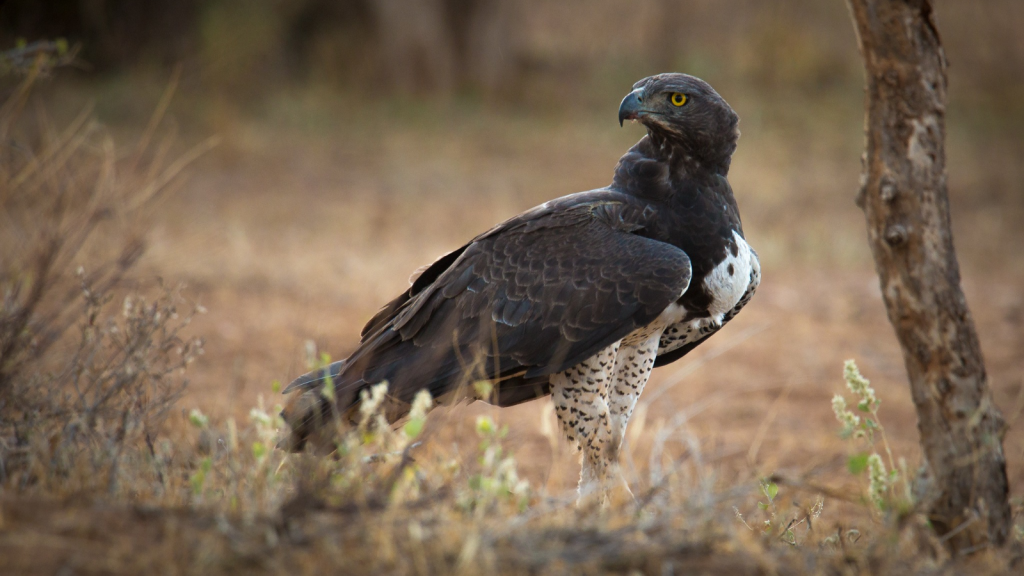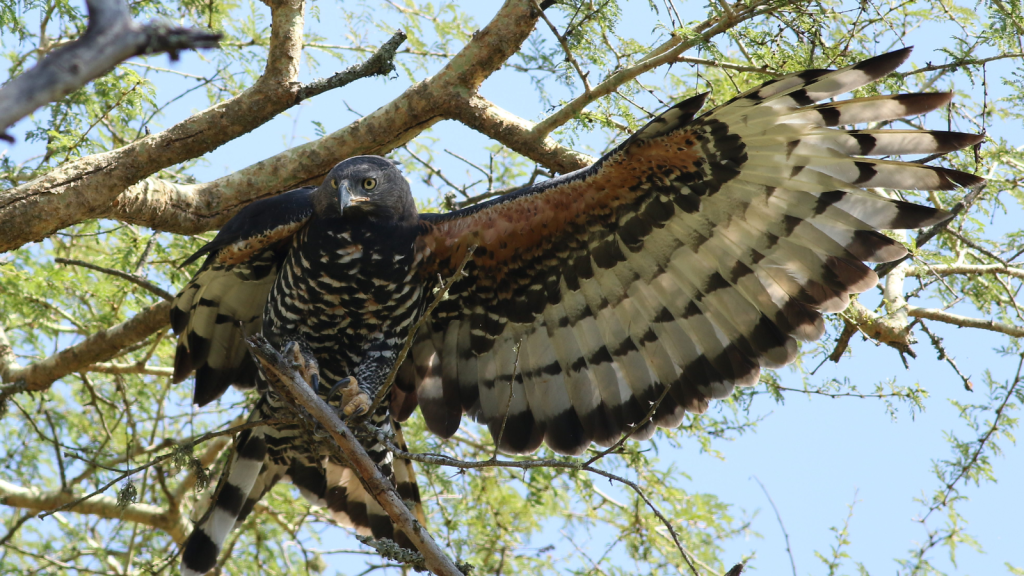The African savannah is home to some of the world’s most famous predators, like lions and cheetahs. But beneath the surface, a whole host of lesser-known hunters prowl the grasslands. These often-overlooked creatures are just as fascinating as their more famous cousins. From nimble nocturnal hunters to crafty pack animals, they each have unique skills that help them survive in this challenging environment. Join us as we explore 15 of these unsung predators, each with its own remarkable story to tell. You might be surprised by some of the animals that made the list!
Serval

The serval is a sleek, spotted cat with unusually long legs and large ears. These features make it a formidable hunter of small prey, especially rodents. Servals can leap up to 3 metres in the air to catch birds mid-flight. Their exceptional hearing allows them to locate prey hiding underground, which they then dig up with their sharp claws. Servals are also known for their incredible success rate, catching their prey in roughly 50% of hunting attempts.
Caracal

Often called the desert lynx, the caracal is known for its distinctive long, black ear tufts. These medium-sized cats are incredible jumpers, capable of snatching multiple birds out of the air in a single bound. Caracals are solitary and mainly nocturnal, making them a rare sight for most savannah visitors. Their powerful hind legs allow them to jump up to 3 metres high, making them one of the most athletic cats in Africa.
African Wild Dog

Also known as the painted wolf, these social canines hunt in packs with remarkable efficiency. African wild dogs are known for their stamina, often chasing prey over long distances until it tires. Their striking coat patterns are unique to each individual, like a fingerprint. These endangered animals have a complex social structure, with only the alpha pair breeding and the whole pack helping to raise the pups.
Honey Badger

Don’t let its small size fool you – the honey badger is one of the savannah’s toughest customers. These fearless animals will take on much larger predators and have even been known to chase young lions away from kills. Their thick, loose skin helps protect them from bites and stings. Honey badgers are also incredibly intelligent, known to use tools and solve complex problems to access food.
Secretary Bird

This long-legged bird of prey stands nearly 1.3 metres tall and is known for its distinctive crest of feathers. Secretary birds are famous for their method of hunting snakes, stomping them with powerful kicks from their legs. They also eat small mammals, lizards, and large insects. Their scientific name, Sagittarius serpentarius, refers to their snake-hunting prowess and their appearance, which early Europeans thought resembled a secretary with quill pens behind their ears.
African Rock Python

As Africa’s largest snake, the rock python is a formidable predator. These constrictors can grow up to 6 metres long and are capable of swallowing prey as large as antelopes. Despite their size, they’re excellent climbers and swimmers, expanding their hunting grounds beyond the savannah floor. Female rock pythons are known for their maternal care, coiling around their eggs to incubate them and protecting their young after hatching.
Martial Eagle

The martial eagle is Africa’s largest eagle, with a wingspan that can reach over 2 metres. These powerful birds can take down prey much larger than themselves, including small antelopes and monkeys. They have incredibly keen eyesight, spotting potential meals from great heights. Martial eagles are known to build massive nests, some weighing up to 90 kg, which they may use for several years.
Black-Backed Jackal

These small canines are adaptable and opportunistic predators. Black-backed jackals hunt in pairs or small family groups, taking down prey much larger than themselves through teamwork. They’re also known to follow larger predators, hoping to scavenge from their kills. These clever animals are monogamous, forming long-term pair bonds and working together to raise their young.
African Hawk-Eagle

This medium-sized eagle is a swift and agile hunter. African hawk-eagles often hunt in pairs, with one bird flushing out prey while the other swoops in for the kill. They primarily target small to medium-sized birds and mammals, including hares and young antelopes. These eagles are known for their spectacular courtship displays, which involve aerial acrobatics and talon-grasping between mates.
Aardwolf

Despite its name meaning “earth wolf,” the aardwolf is actually a member of the hyena family. Unlike its cousins, it specialises in eating termites, using its long, sticky tongue to lap them up. Aardwolves can eat up to 300,000 termites in a single night! Their specialised diet means they play a crucial role in controlling termite populations, which could otherwise cause significant damage to vegetation.
African Wildcat

The ancestor of our domestic cats, the African wildcat is a skilled hunter of small prey. These felines are mainly nocturnal and are rarely seen by humans due to their shy nature. They’re expert climbers and will often sleep in trees to avoid larger predators. African wildcats are so similar to domestic cats that they can interbreed, which is actually a threat to the wild population’s genetic purity.
Bat-Eared Fox

Named for their enormous ears, bat-eared foxes are small but effective predators. They primarily feed on insects, especially harvester termites, using their acute hearing to locate prey. These foxes are highly social, living in pairs or small family groups. Their unique dentition, with more teeth than any other canid, is specially adapted for their insectivorous diet.
African Harrier-Hawk

This uniquely adapted bird of prey has double-jointed knees that allow it to reach into crevices and tree hollows for prey. African harrier-hawks hunt a variety of animals, including small mammals, birds, and even bats. They’re known for their acrobatic hunting style, often hanging upside down to reach into nests or cavities.
Side-Striped Jackal

Less well-known than its black-backed cousin, the side-striped jackal is an omnivorous predator found in the wooded areas of the savannah. These jackals are more shy and less aggressive than other jackal species. They’re opportunistic feeders, hunting small animals and insects, but also eating fruits and berries when available.
Bateleur Eagle

The bateleur, meaning “street performer” in French, is named for its acrobatic flying style. These striking eagles are efficient hunters, preying on small mammals, birds, and reptiles. They spend much of their day in flight, using their keen eyesight to spot prey from great heights. Bateleurs are known for their unusually short tail feathers, which give them a distinctive silhouette in the air.
Meet the Wolf Spider | One of Britain’s Biggest Spiders

Wolf spiders are a remarkable group of arachnids found across the UK and around the world. These agile hunters get their name from their wolf-like hunting style, actively chasing down prey rather than spinning webs. With their large eyes and hairy bodies, wolf spiders might look intimidating, but they’re actually quite beneficial to gardens and homes. These spiders help control pest populations and are generally harmless to humans. From their unique parenting techniques to their impressive hunting skills, wolf spiders are full of surprises.
Read More: Meet the Wolf Spider | One of Britain’s Biggest Spiders
Modern Sea Monsters | 15 Massive Marine Mammals Still Roaming Our Oceans

The oceans of our planet are home to some of the most awe-inspiring creatures on Earth. These marine mammals, with their enormous size and incredible adaptations, seem alien or prehistoric. But an actual up-close interaction with one of these incredible creatures is life-changing. Their lives and sheer size might be unfathomable, but their intelligence and magnificence is clear for all to see. From the largest animal to ever exist to deep-diving behemoths with teeth as big as your arm, these creatures are awe-inspiring and remind us why we need to do more to save our oceans before it’s too late.



